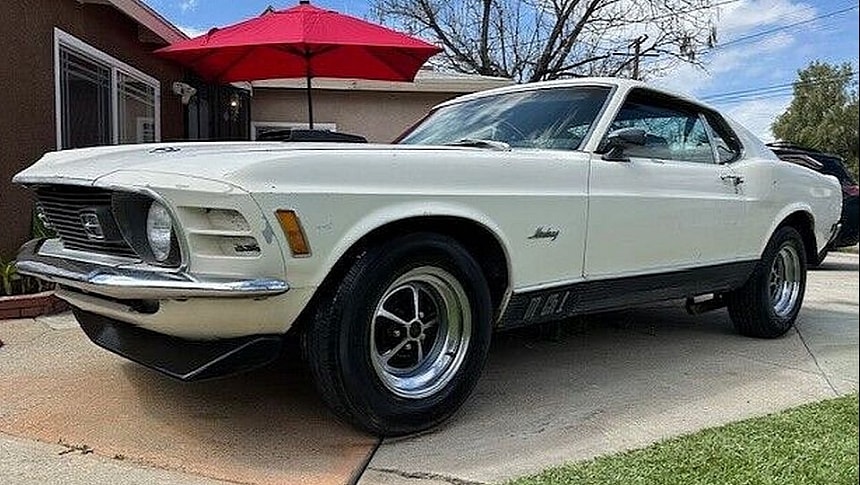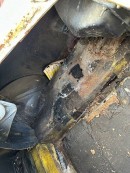Produced for a little more than nine years, the first-generation Ford Mustang got quite a few significant redesigns. The timeline is usually split into four eras: 1964-1966, 1967-1968, 1969-1970, and 1971-1973. Based on this, Ford made notable changes in 1967, 1969, and 1971. However, the third official iteration of the first-gen Mustang also included a 1970 version with a notably different front fascia.
While the 1969 and 1970 Mustangs look largely the same from the side and the rear, things are different above the front bumper. That's because Ford returned to the single headlamp layout and moved them to the inside of the grille. The redesign also added horizontal fins on the outside of the grille.
Some sources claim that the revision was prompted by Ford wanting to make the Mustang less aggressive in response to yet another drop in annual sales. The pony car moved 299,824 units in 1969, a 5.5% decrease compared to the previous year. Mustang sales had dropped for the third consecutive year.
But Ford's strategy didn't work. Mustang deliveries decreased by a whopping 36.4% in 1970, dipping below the 200,000-unit mark for the first time since the 1964 debut. Moreover, the 1970 design soldiered on as one of the least-appealing first-gen Mustangs ever made. I don't agree with this general consensus, but it seems the inside-the-grill lights and the side fins are turn-offs for many people.
If you're also a fan of the supposedly quirky 1970 Mustang and you're on the lookout for a survivor to restore, this barn-found example may be exactly what you want. Survivor is a bit of a long stretch here since the car has been repainted, but according to the seller, everything else is original. This includes the V8 engine, which isn't your regular Ford mill.
This Stang left the assembly line with an R-code powerplant under the hood. That's Ford talk for the 428-cubic-inch (7.0-liter) Cobra Jet. Launched in 1968 and available in this exact format through 1970, it was one of Ford's most potent lumps. Rated at 335 horsepower 440 pound-feet (597 Nm) of torque, it was second only to the 429-cubic-inch (7.0-liter) Boss, which came with 375 horses on tap.
Ford sold no fewer than 18,049 Mustangs equipped with the 428 Cobra Jet from 1968 to 1970 (21,492 if we also include the Shelby GT500s), but most were ordered in 1969. This 'Stang is one of only 3,489 examples sold in 1970. Moreover, it's one of 1,371 Mach 1 Sportsroof models fitted with the R-code unit and the four-speed manual gearbox. That's pretty rare.
So what's the story behind it? Well, the description is rather brief, but the seller mentions that the Mustang was parked sometime in the 1980s. This means it's been off the road for about 40 years. But even though it sat for a very long time, it's described as rust-free. It also spent its life in California.
Granted, the vehicle needs a lot of work to become a Concours-ready gem worth six figures, but it could very well return to the road with a bit of TLC. The car is solid, and the repainted body still looks nice. The interior has only a bit of wear and tear to speak of. The numbers-matching V8 runs, but only as long as you keep feeding it starting fluid.
As for the non-original paint, that's the only tiny secret keeping this Mustang from being a proper survivor. That's because the car left the assembly line yellow instead of white (you can see traces of the original hue inside the trunk). It was most likely finished Bright Yellow, which suits the 1970 Mustang Mach 1 rather well.
Currently sitting in Riverside, California, this Cobra Jet rig is waiting for a new owner who would pay $48,500 to take it home. Do you think it's worth that amount? For reference, a restored example can fetch as much as $150,000 at public auction.
Some sources claim that the revision was prompted by Ford wanting to make the Mustang less aggressive in response to yet another drop in annual sales. The pony car moved 299,824 units in 1969, a 5.5% decrease compared to the previous year. Mustang sales had dropped for the third consecutive year.
But Ford's strategy didn't work. Mustang deliveries decreased by a whopping 36.4% in 1970, dipping below the 200,000-unit mark for the first time since the 1964 debut. Moreover, the 1970 design soldiered on as one of the least-appealing first-gen Mustangs ever made. I don't agree with this general consensus, but it seems the inside-the-grill lights and the side fins are turn-offs for many people.
If you're also a fan of the supposedly quirky 1970 Mustang and you're on the lookout for a survivor to restore, this barn-found example may be exactly what you want. Survivor is a bit of a long stretch here since the car has been repainted, but according to the seller, everything else is original. This includes the V8 engine, which isn't your regular Ford mill.
This Stang left the assembly line with an R-code powerplant under the hood. That's Ford talk for the 428-cubic-inch (7.0-liter) Cobra Jet. Launched in 1968 and available in this exact format through 1970, it was one of Ford's most potent lumps. Rated at 335 horsepower 440 pound-feet (597 Nm) of torque, it was second only to the 429-cubic-inch (7.0-liter) Boss, which came with 375 horses on tap.
Ford sold no fewer than 18,049 Mustangs equipped with the 428 Cobra Jet from 1968 to 1970 (21,492 if we also include the Shelby GT500s), but most were ordered in 1969. This 'Stang is one of only 3,489 examples sold in 1970. Moreover, it's one of 1,371 Mach 1 Sportsroof models fitted with the R-code unit and the four-speed manual gearbox. That's pretty rare.
So what's the story behind it? Well, the description is rather brief, but the seller mentions that the Mustang was parked sometime in the 1980s. This means it's been off the road for about 40 years. But even though it sat for a very long time, it's described as rust-free. It also spent its life in California.
Granted, the vehicle needs a lot of work to become a Concours-ready gem worth six figures, but it could very well return to the road with a bit of TLC. The car is solid, and the repainted body still looks nice. The interior has only a bit of wear and tear to speak of. The numbers-matching V8 runs, but only as long as you keep feeding it starting fluid.
As for the non-original paint, that's the only tiny secret keeping this Mustang from being a proper survivor. That's because the car left the assembly line yellow instead of white (you can see traces of the original hue inside the trunk). It was most likely finished Bright Yellow, which suits the 1970 Mustang Mach 1 rather well.
Currently sitting in Riverside, California, this Cobra Jet rig is waiting for a new owner who would pay $48,500 to take it home. Do you think it's worth that amount? For reference, a restored example can fetch as much as $150,000 at public auction.










